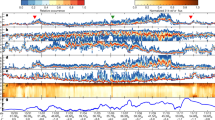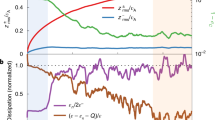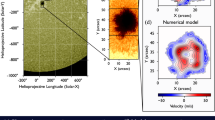Abstract
Direct observations over the past four centuries1 show that the number of sunspots observed on the Sun’s surface varies periodically, going through successive maxima and minima. Following sunspot cycle 23, the Sun went into a prolonged minimum characterized by a very weak polar magnetic field2,3 and an unusually large number of days without sunspots4. Sunspots are strongly magnetized regions5 generated by a dynamo mechanism6 that recreates the solar polar field mediated through plasma flows7. Here we report results from kinematic dynamo simulations which demonstrate that a fast meridional flow in the first half of a cycle, followed by a slower flow in the second half, reproduces both characteristics of the minimum of sunspot cycle 23. Our model predicts that, in general, very deep minima are associated with weak polar fields. Sunspots govern the solar radiative energy8,9 and radio flux, and, in conjunction with the polar field, modulate the solar wind, the heliospheric open flux and, consequently, the cosmic ray flux at Earth3,10,11.
This is a preview of subscription content, access via your institution
Access options
Subscribe to this journal
Receive 51 print issues and online access
$199.00 per year
only $3.90 per issue
Buy this article
- Purchase on Springer Link
- Instant access to full article PDF
Prices may be subject to local taxes which are calculated during checkout



Similar content being viewed by others
References
Hoyt, D. V. & Schatten, K. H. Group sunspot numbers: a new solar activity reconstruction. Sol. Phys. 179, 189–219 (1998)
Schrijver, C. J. & Liu, Y. The global solar magnetic field through a full sunspot cycle: observations and model results. Sol. Phys. 252, 19–31 (2008)
Wang, Y.-M., Robbrecht, E. & Sheeley, N. R., Jr On the weakening of the polar magnetic fields during solar cycle 23. Astrophys. J. 707, 1372–1386 (2009)
Solar Influences Data Analysis Center. Daily sunspot number 〈http://sidc.oma.be/sunspot-data/dailyssn.php〉 (2011)
Solanki, S. K. Sunspots: an overview. Astron. Astrophys. Rev. 11, 153–286 (2003)
Charbonneau, P. Dynamo models of the solar cycle. Living Rev. Solar Phys. 7, 3 〈http://solarphysics.livingreviews.org/Articles/lrsp-2010-3/〉 (2010)
Muñoz-Jaramillo, A., Nandy, D., Martens, P. C. H. & Yeates, A. R. A double-ring algorithm for modeling solar active regions: unifying kinematic dynamo models and surface flux-transport simulations. Astrophys. J. 720, L20–L25 (2010)
Krivova, N. A., Balmaceda, L. & Solanki, S. K. Reconstruction of the solar total irradiance since 1700 from the surface magnetic flux. Astron. Astrophys. 467, 335–346 (2007)
Lean, J. The Sun’s variable radiation and its relevance for Earth. Annu. Rev. Astron. Astrophys. 35, 33–67 (1997)
Solanki, S. K., Schüssler, M. & Fligge, M. Evolution of the Sun’s large-scale magnetic field since the Maunder minimum. Nature 408, 445–447 (2000)
Lara, A. et al. Coronal mass ejections and galactic cosmic-ray modulation. Astrophys. J. 625, 441–450 (2005)
Babcock, H. W. The topology of the Sun’s magnetic field and the 22-year cycle. Astrophys. J. 133, 572–587 (1961)
Leighton, R. B. A magneto-kinematic model of the solar cycle. Astrophys. J. 156, 1–26 (1969)
Choudhuri, A. R., Schussler, M. & Dikpati, M. The solar dynamo with meridional circulation. Astron. Astrophys. 303, L29–L32 (1995)
Dikpati, M., de Toma, G. & Gilman, P. A. Predicting the strength of solar cycle 24 using a flux-transport dynamo-based tool. Geophys. Res. Lett. 33, L05102 (2006)
Choudhuri, A. R., Chatterjee, P. & Jiang, J. Predicting solar cycle 24 with a solar dynamo model. Phys. Rev. Lett. 98, 131103 (2007)
Yeates, A. R., Nandy, D. & Mackay, D. H. Exploring the physical basis of solar cycle predictions: flux transport dynamics and persistence of memory in advection- versus diffusion-dominated solar convection zones. Astrophys. J. 673, 544–556 (2008)
Giles, P. M., Duvall, T. L., Scherrer, P. H. & Bogart, R. S. A subsurface flow of material from the Sun’s equator to its poles. Nature 390, 52–54 (1997)
Zhao, J. & Kosovichev, A. G. Torsional oscillation, meridional flows, and vorticity inferred in the upper convection zone of the Sun by time-distance helioseismology. Astrophys. J. 603, 776–784 (2004)
González Hernández, I. et al. Meridional circulation variability from large-aperture ring-diagram analysis of global oscillation network group and Michelson Doppler imager data. Astrophys. J. 638, 576–583 (2006)
Švanda, M., Kosovichev, A. G. & Zhao, J. Speed of meridional flows and magnetic flux transport on the Sun. Astrophys. J. 670, L69–L72 (2007)
Hathaway, D. H., Nandy, D., Wilson, R. M. & Reichmann, E. J. Evidence that a deep meridional flow sets the sunspot cycle period. Astrophys. J. 589, 665–670 (2003)
Nandy, D. & Choudhuri, A. R. Explaining the latitudinal distribution of sunspots with deep meridional flow. Science 296, 1671–1673 (2002)
Muñoz-Jaramillo, A., Nandy, D. & Martens, P. C. H. Helioseismic data inclusion in solar dynamo models. Astrophys. J. 698, 461–478 (2009)
Durney, B. R. On a Babcock-Leighton solar dynamo model with a deep-seated generating layer for the toroidal magnetic field. IV. Astrophys. J. 486, 1065–1077 (1997)
Nandy, D. & Choudhuri, A. R. Toward a mean field formulation of the Babcock-Leighton type solar dynamo. I. α-coefficient versus Durney’s double-ring approach. Astrophys. J. 551, 576–585 (2001)
Rempel, M. Origin of solar torsional oscillations. Astrophys. J. 655, 651–659 (2007)
Jiang, J., Işik, E., Cameron, R. H., Schmitt, D. & Schüssler, M. The effect of activity-related meridional flow modulation on the strength of the solar polar magnetic field. Astrophys. J. 717, 597–602 (2010)
Acknowledgements
This work was supported through the Ramanujan Fellowship of the Government of India at the Indian Institute of Science Education and Research, Kolkata, and by a NASA Living With a Star grant to the Smithsonian Astrophysical Observatory and Montana State University. We are grateful to D. Hathaway for providing the observational data on days without sunspots; the analysis of these data is reported in Supplementary Fig. 1.
Author information
Authors and Affiliations
Contributions
D.N. conceived the principal idea and, in conjunction with P.C.H.M. and A.M.-J., planned the simulations, which were performed by A.M.J. under the guidance of D.N. and P.C.H.M. D.N. led the interpretation of the results and all authors contributed to writing the paper.
Corresponding author
Ethics declarations
Competing interests
The authors declare no competing financial interests.
Supplementary information
Supplementary Information
This file contains Supplementary Text and Data comprising a description of the observed characteristics of the minimum of solar cycle 23, details of the dynamo model used for the simulations, an analysis of sensitivity of results to parameter changes and a note on solar plasma flow observations, Supplementary Figures 1-4 with legends, Supplementary Tables 1-3 and additional references. (PDF 311 kb)
Rights and permissions
About this article
Cite this article
Nandy, D., Muñoz-Jaramillo, A. & Martens, P. The unusual minimum of sunspot cycle 23 caused by meridional plasma flow variations. Nature 471, 80–82 (2011). https://doi.org/10.1038/nature09786
Received:
Accepted:
Published:
Issue Date:
DOI: https://doi.org/10.1038/nature09786
This article is cited by
-
Physical Models for Solar Cycle Predictions
Space Science Reviews (2023)
-
Mean Field Models of Flux Transport Dynamo and Meridional Circulation in the Sun and Stars
Space Science Reviews (2023)
-
Progress in Solar Cycle Predictions: Sunspot Cycles 24–25 in Perspective
Solar Physics (2021)
-
Concept of the solar ring mission: An overview
Science China Technological Sciences (2020)
-
Forecasting Solar Cycle 25 Using Deep Neural Networks
Solar Physics (2020)
Comments
By submitting a comment you agree to abide by our Terms and Community Guidelines. If you find something abusive or that does not comply with our terms or guidelines please flag it as inappropriate.



